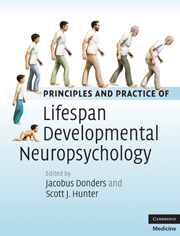Book contents
- Frontmatter
- Contents
- Contact information for authors
- Biography for Jacobus Donders and Scott J. Hunter
- Introduction
- Section I Theory and models
- Section II Disorders
- 5a Attention deficit hyperactivity disorder in children and adolescents
- 5b Attention deficit hyperactivity disorder in adults
- 5c Attention deficit hyperactivity disorder: a lifespan synthesis
- 6a Learning disorders in children and adolescents
- 6b Learning disorders in adults
- 6c Synthesis of chapters on learning disabilities: overview and additional perspectives
- 7a Infants and children with spina bifida
- 7b Adolescence and emerging adulthood in individuals with spina bifida: a developmental neuropsychological perspective
- 7c Spina bifida/myelomeningocele and hydrocephalus across the lifespan: a developmental synthesis
- 8 Cerebral palsy across the lifespan
- 9a Intellectual disability across the lifespan
- 9b Lifespan aspects of PDD/autism spectrum disorders (ASD)
- 9c Autism spectrum disorders and intellectual disability: common themes and points of divergence
- 10a Hearing loss across the lifespan: neuropsychological perspectives
- 10b Visual impairment across the lifespan: neuropsychological perspectives
- 11a Traumatic brain injury in childhood
- 11b Adult outcomes of pediatric traumatic brain injury
- 11c Neurobehavioral aspects of traumatic brain injury sustained in adulthood
- 11d Traumatic brain injury in older adults
- 11e Traumatic brain injury across the lifespan: a long-term developmental perspective
- 12a Pediatric aspects of epilepsy
- 12b A lifespan perspective of cognition in epilepsy
- 13a Leukemia and lymphoma across the lifespan
- 13b Lifespan aspects of brain tumors
- 14 Lifespan aspects of endocrine disorders
- 15 Metabolic and neurodegenerative disorders across the lifespan
- 16a Psychopathological conditions in children and adolescents
- 16b Psychopathological conditions in adults
- 16c Neuropsychological aspects of psychopathology across the lifespan: a synthesis
- Index
- Plate section
- References
5a - Attention deficit hyperactivity disorder in children and adolescents
from Section II - Disorders
Published online by Cambridge University Press: 07 May 2010
- Frontmatter
- Contents
- Contact information for authors
- Biography for Jacobus Donders and Scott J. Hunter
- Introduction
- Section I Theory and models
- Section II Disorders
- 5a Attention deficit hyperactivity disorder in children and adolescents
- 5b Attention deficit hyperactivity disorder in adults
- 5c Attention deficit hyperactivity disorder: a lifespan synthesis
- 6a Learning disorders in children and adolescents
- 6b Learning disorders in adults
- 6c Synthesis of chapters on learning disabilities: overview and additional perspectives
- 7a Infants and children with spina bifida
- 7b Adolescence and emerging adulthood in individuals with spina bifida: a developmental neuropsychological perspective
- 7c Spina bifida/myelomeningocele and hydrocephalus across the lifespan: a developmental synthesis
- 8 Cerebral palsy across the lifespan
- 9a Intellectual disability across the lifespan
- 9b Lifespan aspects of PDD/autism spectrum disorders (ASD)
- 9c Autism spectrum disorders and intellectual disability: common themes and points of divergence
- 10a Hearing loss across the lifespan: neuropsychological perspectives
- 10b Visual impairment across the lifespan: neuropsychological perspectives
- 11a Traumatic brain injury in childhood
- 11b Adult outcomes of pediatric traumatic brain injury
- 11c Neurobehavioral aspects of traumatic brain injury sustained in adulthood
- 11d Traumatic brain injury in older adults
- 11e Traumatic brain injury across the lifespan: a long-term developmental perspective
- 12a Pediatric aspects of epilepsy
- 12b A lifespan perspective of cognition in epilepsy
- 13a Leukemia and lymphoma across the lifespan
- 13b Lifespan aspects of brain tumors
- 14 Lifespan aspects of endocrine disorders
- 15 Metabolic and neurodegenerative disorders across the lifespan
- 16a Psychopathological conditions in children and adolescents
- 16b Psychopathological conditions in adults
- 16c Neuropsychological aspects of psychopathology across the lifespan: a synthesis
- Index
- Plate section
- References
Summary
ADHD Phenomenology
Attention deficit hyperactivity disorder (ADHD) is a complex psychiatric syndrome characterized by developmentally excessive manifestations of inattention, hyperactivity, and impulsivity which have their onset prior to age 7 and are associated with impairments in at least two domains of psychosocial functioning (e.g. scholastic achievement, family interactions, peer relations) [1]. Widely considered to be the most common psychiatric disorder of childhood, ADHD affects approximately 5% of school-aged children worldwide [2], with diagnostic rates in males exceeding those of females by 4:1 in non-referred investigations and 9:1 in clinically referred samples [3].
Comorbidity profiles in children with ADHD
Upwards of two-thirds of children and adolescents with the disorder meet criteria for one or more comorbid psychiatric conditions. In particular, approximately 50–60% meet criteria for oppositional defiant disorder (ODD), 30–50% meet criteria for conduct disorder (CD), 25% meet criteria for one or more anxiety disorders, and 15–25% have a comorbid mood disorder [4]. Relative to same-aged peers, children with ADHD are also at heightened risk for tic disorders, learning disabilities, and substance use disorders [4]. The high prevalence of psychiatric comorbidity among youth with ADHD may reflect common etiological mechanisms and/or temperamental features (e.g. impulsivity), as well as associated psychosocial consequences of the disorder (e.g. demoralization stemming from impaired social functioning). ADHD is also considered a significant risk factor for adverse outcomes during adolescence and adulthood [5]; however, the relative contributions of ADHD vs. psychiatric comorbidity to subsequent outcomes have been difficult to isolate.
- Type
- Chapter
- Information
- Publisher: Cambridge University PressPrint publication year: 2010

